| Home Login Register |
| Satellite Internet forum › Dish pointing and alignment › dish pointing angle for W6 |
|
Pages: 1
|
dish pointing angle for W6(Read 9946 times) |
|
theodis.jefferson
Member
★★ Offline Posts: 3 |
Feb 24th, 2011 at 6:47am
|
| Back to top |
IP Logged
|
|
Eric Johnston
Senior Member
★★★ Offline Posts: 2109 |
Reply #1 - Feb 24th, 2011 at 7:40am
|
| Back to top |
« Last Edit: Feb 24th, 2011 at 9:38am by Eric Johnston »
IP Logged
|
|
Saif Musa
Member
★★ Offline Posts: 23 |
Reply #2 - Feb 24th, 2011 at 8:15am
|
| Back to top |
saif.musa@ymail.com&&it.vsat@oil.gov.iq&&system engineer
IP Logged
|
|
theodis.jefferson
Member
★★ Offline Posts: 3 |
Reply #3 - Feb 24th, 2011 at 8:46am
|
| Back to top |
IP Logged
|
|
Eric Johnston
Senior Member
★★★ Offline Posts: 2109 |
Reply #4 - Feb 24th, 2011 at 9:28am
|
| Back to top |
« Last Edit: Feb 24th, 2011 at 12:13pm by Eric Johnston »
IP Logged
|
|
theodis.jefferson
Member
★★ Offline Posts: 3 |
Reply #5 - Feb 24th, 2011 at 7:10pm
|
| Back to top |
IP Logged
|
|
Eric Johnston
Senior Member
★★★ Offline Posts: 2109 |
Reply #6 - Feb 24th, 2011 at 8:51pm
|
| Back to top |
IP Logged
|
|
Pages: 1
|
Email me: eric@satsig.net
Powered by YaBB 2.5.2!
YaBB Forum Software © 2000-. All Rights Reserved.
Disclaimer, Terms of Use and Privacy Forum User Agreement Forum rules Cookie policy.





